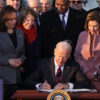If Energy Freedom Day seems like a long time ago, it was. It’s been since September of 2008 since the Congressional restrictions on energy leasing in 85 percent of America’s territorial waters, which have been renewed annually since 1982, were allowed to lapse. Along with the White House restrictions rescinded by President Bush, it opened nearly all of our federally controlled waters for energy leasing. A lot has happened since, but there’s been no real movement forward on drilling.
The leasing process began with a comment period – extended six months by Department of Interior Secretary Ken Salazar. Vince Haley details the subsequent actions from the government:
“More than four months after the comment period ended, the Department of the Interior has failed to make any public announcement about the results, even though sources have told American Solutions for months the comments show a 2-1 advantage in support of offshore drilling.
It took American Solutions almost four months and the power of the Freedom of Information Act to finally uncover indirect confirmation that, out of over 530,000 comments submitted, pro-drilling comments outnumbered anti-drilling comments by a 2-1 margin.
In an email dated October 27, 2009, Liz Birnbaum, director of the Minerals Management Service, informs other Interior officials that a preliminary tabulation of the results of the comment period had not yet gone to Secretary Salazar, adding “[s]o the Secretary can honestly say in response to any questions that he’s [SIC] has not yet seen the analysis of the comments – staff is still working on it. I did, however, confirm to him the 2-1 split that these guys [at American Solutions] are emphasizing.”
46,573 people used The Heritage Foundation’s Free Our Energy site to submit comments to the Department of the Interior. In essence, the administration is saying: We’ll be transparent, except when it doesn’t behoove us to be.
The process of leasing and subsequent exploration and drilling takes a number of years. In fact, those opposed to drilling often argue that since it takes years for the oil to become commercially available, we shouldn’t be doing that. Of course, they’ve been saying that for decades and that oil could be on the market if we acted then.
Instead, logical personality would reduce the time period it takes for the drill to hit the ground. Part of the delays are due to multiple layers of regulatory red tape, and several opportunities for anti-energy activists to file administrative appeals and lawsuits. Several bills, including the Drill Now Act, the No Cost Stimulus and The American Energy Act attempt to do this. Any sound policy would:
• Permanently End Bans on Offshore Drilling in Atlantic, Pacific, Eastern Gulf of Mexico and Oil Shale Areas.
• Expedite Leasing Process: Allows the Mineral Management Service to being preleasing and leasing activities immediately, without the need to completely write a new 5-year leasing plan.
• Expedite Judicial Review of Environmental Lawsuits: Allow only 90 days to submit a legal case to U.S. District Courts. Any appeal of a district court can only be made in the U.S. District Court of Appeals in D.C. Limits judicial review for how the Secretary enforces laws.
Government inaction simply doesn’t make sense. Offshore drilling will create jobs and increase energy supply without cost to the taxpayer. It will create revenues for financially strapped state government and increase revenues for federal governments. President Obama said in his State of the Union address that we should make tough decisions about offshore drilling. It sounds like a pretty easy decision.


























